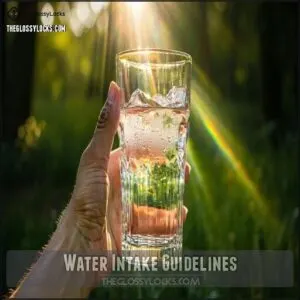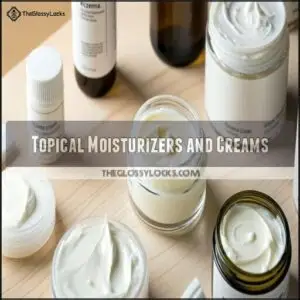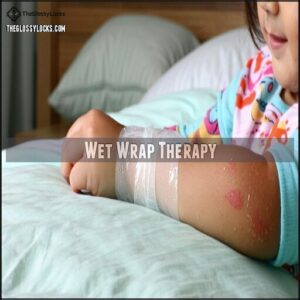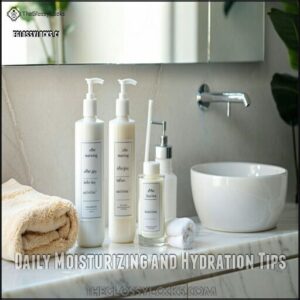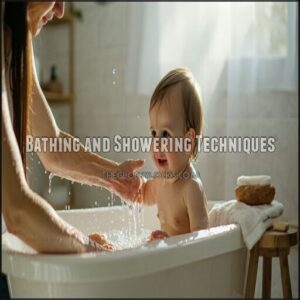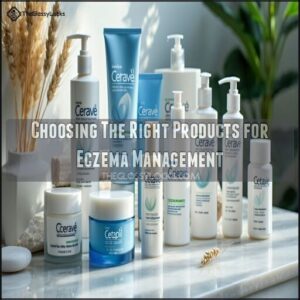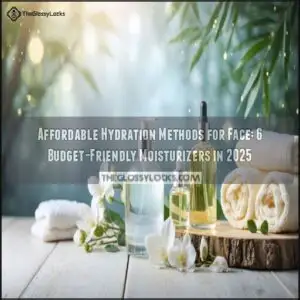This site is supported by our readers. We may earn a commission, at no cost to you, if you purchase through links.

Practice the "soak and seal" method—bathe in lukewarm water for 10-15 minutes, then immediately apply a thick moisturizer while skin is still damp.
Choose fragrance-free products with ceramides, hyaluronic acid, or colloidal oatmeal.
Don’t skimp on internal hydration; drink plenty of water throughout the day.
Apply moisturizer at least twice daily, and consider overnight treatments with cotton gloves or socks.
Cool compresses can calm flare-ups when your skin feels like it’s throwing a tantrum.
The right hydration routine isn’t just about comfort—it’s your skin’s shield against triggers and helps with overall skin care, providing effective management of eczema symptoms.
Table Of Contents
- Key Takeaways
- Eczema Hydration Basics
- Water Intake Guidelines
- Hydrating Skin Effectively
- Dehydration and Eczema
- Effective Skincare Routines
- Frequently Asked Questions (FAQs)
- How to hydrate skin with eczema?
- How do you rehydrate eczema?
- How do you stay hydrated with eczema?
- What role does humidity play in eczema management?
- How does diet affect skin hydration levels?
- Can exercise impact eczema hydration needs?
- Do seasonal changes require different hydration approaches?
- Are hydration needs different for children with eczema?
- Conclusion
Key Takeaways
- Use the "soak and seal" method by bathing in lukewarm water for 10-15 minutes, then immediately applying a thick moisturizer to damp skin to lock in hydration and repair your compromised skin barrier.
- Choose fragrance-free moisturizers containing ceramides, hyaluronic acid, or colloidal oatmeal, and apply them at least twice daily, focusing on consistency rather than quantity.
- Don’t rely solely on drinking water to manage eczema, but maintain proper internal hydration (about 2.7 liters daily for women and 3.7 liters for men) to support your skin’s overall health.
- Adjust your hydration approach seasonally, using heavier moisturizers in winter and lighter but more frequent applications in summer, while maintaining indoor humidity levels between 30-50%.
Eczema Hydration Basics
Your weakened skin barrier is the key to understanding why eczema leaves you feeling like a dried-out sponge in the desert.
You’ll need to master proper hydration techniques to repair this barrier, prevent moisture loss, and break the frustrating cycle of dryness that triggers those uncomfortable flares, which is crucial for maintaining healthy skin and avoiding eczema.
Skin Barrier Function
At the heart of your eczema struggles lies a compromised skin barrier function. Your skin’s protective wall isn’t performing its job properly, allowing moisture to escape while letting irritants in.
- Filaggrin deficiency weakens your natural defense system
- Altered lipid composition disrupts moisture retention
- Increased TEWL (Trans-Epidermal Water Loss) dehydrates skin cells
- Reduced ceramide levels compromise barrier integrity
- Chronic inflammation cycles worsen barrier repair processes
Understanding these mechanisms helps you tackle eczema hydration more effectively, and addressing the compromised skin barrier is crucial for managing eczema.
Dry Skin Triggers
Now that you understand how your skin’s protective barrier works, let’s look at what sets off dry skin.
Several dry skin triggers can kickstart an eczema flare, including environmental factors like low humidity and harsh weather.
Allergen exposure, irritant contact from soaps or detergents, climate impact (especially winter), and even high stress levels can compromise your skin’s moisture balance.
Recognizing these triggers is your first step toward effective dry skin relief.
Moisture Loss and Irritant Exposure
The skin’s protective shield breaks down with eczema, creating a two-way problem.
Your compromised barrier function leads to increased transepidermal water loss (TEWL) while simultaneously allowing irritants to penetrate deeper. This dryness cycle triggers inflammation, making skin sensitivity worse.
Environmental aggravators like harsh soaps, weather changes, and allergens can further damage your eczema skin barrier, creating a frustrating loop of moisture loss and irritation.
Many find relief using fragrance-free hypoallergenic products, which can help break the cycle of moisture loss.
Water Intake Guidelines
You’ll need to maintain adequate water intake by consuming the recommended daily amount—about 2.7 liters for women and 3.7 liters for men.
Though simply drinking more won’t directly cure your eczema symptoms, your body’s hydration needs depend on factors like your age, activity level, and climate.
Monitor your urine color (aim for clear or light yellow) to verify you’re properly hydrated for superior skin health.
Daily Water Recommendations
Wondering how much water you should drink for eczema management?
While the National Academies recommends about 2.7 liters daily for women and 3.7 liters for men, there’s no direct proof that exceeding these amounts improves eczema symptoms.
A simple guideline: divide your weight in pounds by two for your ideal water consumption in ounces.
Monitor your hydration status through urine color—aim for clear or very light.
Individual Hydration Needs
Your body’s hydration needs aren’t one-size-fits-all. Fluid requirements vary dramatically based on your age-specific intake, activity levels, climate impact, and health conditions like eczema.
While general guidelines suggest 11.5 cups for women and 15.5 cups for men daily, these are just starting points.
Consider incorporating water-rich foods into your diet and monitoring consumption through urine color—clear or light yellow indicates proper hydration status.
Adequate hydration also strengthens hair strands, potentially reducing breakage.
Effects of Excessive Water Consumption
Despite what wellness influencers might suggest, drinking excessive water won’t improve your eczema.
Too much water can actually lead to electrolyte imbalance and hyponatremia risks, where sodium levels drop dangerously low.
Your kidneys can become overloaded, potentially causing edema concerns and fluid balance issues.
For ideal skin hydration without complications, stick to recommended daily amounts rather than forcing yourself to chug gallons hoping for miracle results.
Hydrating Skin Effectively
You’ll need to apply moisturizers directly to your skin to repair your damaged barrier and lock in essential hydration.
Techniques like the soak-and-seal method can dramatically improve your eczema symptoms by trapping moisture where it’s needed most, which is a key concept to understand for managing eczema symptoms.
Topical Moisturizers and Creams
The three main moisturizer types for eczema hydration methods include ointment, creams, and lotions—each with different oil-to-water ratios.
Ointments offer the highest oil content for maximum protection, while creams provide a balance of moisture and absorption.
For best results, apply your chosen moisturizer within 3 minutes after bathing, and reapply at least twice daily.
Look for emollient benefits from ingredients like ceramides, colloidal oatmeal, and glycerin.
Many people find relief using specialized eczema creams.
Soak and Seal Method
While moisturizers are powerful eczema fighters, the soak and seal method takes hydration to another level.
After a 10-15 minute lukewarm bath, pat your skin until it’s damp (not dry), then immediately apply any prescribed steroids.
Follow with a thick moisturizer within three minutes to lock in hydration, creating a water-trapping sandwich that dramatically improves moisture retention and reducing flare frequency.
Using a humidifier can further improve hydration, as it helps add moisture indoors, which is an essential part of eczema hydration and can lead to better moisture retention.
Wet Wrap Therapy
Wrap your eczema into submission with wet wrap therapy, a powerful technique for moderate to severe atopic dermatitis that delivers deep hydration where you need it most.
For those seeking specialized products, consider eczema-specific wraps.
For effective skin hydration:
- Apply medication and moisturizer to affected areas
- Cover with warm, damp gauze or fabric
- Add a dry layer over the wet wrap
- Leave in place for several hours or overnight
Dehydration and Eczema
Your body’s internal hydration directly impacts your eczema symptoms, with dehydration weakening your skin barrier and amplifying inflammation.
You’ll notice your skin becomes more brittle and reactive when you’re not properly hydrated, making consistent water intake just as essential as your external moisturizing routine, which is crucial for maintaining healthy skin and reducing inflammation.
Weaker Skin Barrier Function
When your skin becomes dehydrated, its natural protective barrier weakens substantially.
Your skin’s barrier function relies on ceramide levels and proper lipid composition to lock moisture in. With eczema, you’re already battling filaggrin deficiency, which compromises this shield.
Dehydration worsens the problem, causing TEWL increase (Transepidermal Water Loss).
Think of your skin barrier like a brick wall—without enough water, the mortar crumbles, leaving your skin vulnerable to irritants that trigger atopic dermatitis flares.
Increased Inflammation and Immune System Impact
Dehydration acts like fuel for the inflammatory fire in your eczema-prone skin.
When you’re not properly hydrated, inflammation markers rise and your immune system becomes dysregulated.
This triggers excessive cytokine release, worsening skin inflammation and potentially causing systemic effects throughout your body.
The connection between gut health and skin inflammation becomes more pronounced too, creating a vicious cycle that makes your eczema symptoms harder to manage, involving a complex interplay of systemic effects.
Factors Interfering With Optimum Hydration
While inflammation takes a toll on your skin, several factors can sabotage your hydration efforts when managing eczema.
Your environment and habits play a huge role in how well your body maintains moisture levels.
Here are common hydration saboteurs that affect your skin barrier function:
- Dietary restrictions that limit water-rich foods
- Sugary drinks that cause dehydration rather than hydration
- Alcohol consumption that depletes moisture reserves
- Climate factors like low humidity or excessive heat
- Activity levels that increase water loss through sweating
Effective Skincare Routines
You’ll find your eczema responds best to consistent skincare that prioritizes hydration immediately after bathing.
Applying fragrance-free moisturizers within three minutes of toweling off creates a protective seal that locks in moisture and helps repair your skin’s compromised barrier.
Daily Moisturizing and Hydration Tips
Now that you understand how dehydration impacts your eczema, let’s look at daily practices that make a real difference.
Your moisturizing routine doesn’t need to be complicated—it just needs to be consistent. For best results, consider product layering techniques to enhance absorption.
Here’s a quick reference guide for your daily hydration routine:
| Time of Day | Moisturizer Type | Application Tips |
|---|---|---|
| Morning | Lighter creams/lotions | Apply within 3 minutes after washing |
| After Shower | Ointments or creams | Pat skin damp, don’t rub dry |
| Throughout Day | Portable moisturizers | Reapply after handwashing |
| Before Activities | Barrier creams | Focus on problem areas |
| Bedtime | Heavier ointments | Apply generously all over |
The key to a successful routine is consistency and using the right moisturizer type for each part of your day. By following this guide, you can develop a daily hydration routine that works for you and helps manage your eczema. Remember to apply generously and focus on problem areas for the best results.
Bathing and Showering Techniques
Now that you’ve established a daily moisturizing routine, let’s talk about your bathing habits.
Proper bathing techniques can make or break your eczema management.
For bath frequency, less is actually more—most children need bathing only once or twice weekly.
Keep water temperature lukewarm, not hot, and limit soak duration to 5-10 minutes.
Always follow with post-bath moisturizing within three minutes while your skin remains damp, which is crucial for proper bathing techniques.
Choosing The Right Products for Eczema Management
The right skincare arsenal makes all the difference in your eczema management journey.
Look for products with the National Eczema Association seal of acceptance. CeraVe, Cetaphil, and Vanicream offer excellent eczema-friendly products that won’t break the bank.
Always test new items on a small patch first, and remember that thicker, fragrance-free moisturizers with ceramides provide better hydration for your compromised skin barrier.
Many individuals find relief using specialized emollient products.
Frequently Asked Questions (FAQs)
How to hydrate skin with eczema?
Over 31 million Americans have eczema. You’ll hydrate your skin best by applying moisturizer within three minutes after bathing, using fragrance-free ointments, and implementing the "soak and seal" method regularly.
How do you rehydrate eczema?
Apply moisturizer to damp skin after bathing, use fragrance-free ointments, try wet wrap therapy, and drink adequate water. These methods help seal moisture in your skin and reduce eczema flare-ups.
How do you stay hydrated with eczema?
Drink plenty of water daily, but don’t expect it to cure eczema alone.
Complement your water intake with moisturizers, proper bathing habits, and avoiding dehydrating beverages like alcohol and sugary drinks.
What role does humidity play in eczema management?
Like a temperamental artist, humidity shapes your skin’s comfort.
You’ll need balanced indoor levels (30-50%) to protect your skin barrier.
Too dry causes cracking; too humid triggers sweating and flares.
Consider a humidifier during winter months to maintain a balance and prevent skin issues, as balanced indoor levels are crucial.
How does diet affect skin hydration levels?
Your diet substantially impacts skin hydration. Water-rich foods like cucumbers and watermelon boost moisture levels, while sugary drinks and alcohol can dehydrate your skin, potentially worsening eczema symptoms.
Can exercise impact eczema hydration needs?
Your body’s river flows faster during workouts, increasing water loss. You’ll need extra hydration when exercising with eczema, as sweat can trigger flares and dry your skin. Replenish what’s lost.
Do seasonal changes require different hydration approaches?
Yes, seasonal changes definitely affect your eczema care routine. You’ll need more moisturizer in winter’s dry air, while summer requires lighter hydration but more frequent application after swimming or sweating.
Are hydration needs different for children with eczema?
Children with eczema need consistent hydration routines, but their smaller bodies require age-appropriate water intake.
You’ll want to focus on moisturizing their skin directly rather than increasing their fluid consumption beyond normal recommendations.
Conclusion
Managing eczema starts with hydration—it’s scientifically proven that proper moisture balance transforms skin health.
By implementing these effective hydration methods for eczema, you’ll notice significant improvements in comfort and appearance.
Remember, consistency is key. Apply moisturizers diligently, drink plenty of water, and don’t hesitate to try wet wrap therapy when needed.
Your skin’s natural barrier will strengthen over time, reducing flare-ups and irritation. You’ve got this—healthier skin is within reach through dedicated hydration practices.
- https://www.paul-yamauchi.com/
- https://www.ncbi.nlm.nih.gov/pmc/articles/PMC9954916/
- https://www.nationalacademies.org/news/2004/02/report-sets-dietary-intake-levels-for-water-salt-and-potassium-to-maintain-health-and-reduce-chronic-disease-risk
- https://theordinary.com/en-ca/soothing-barrier-support-serum-100634.html
- http://clinicaltrials.gov/


